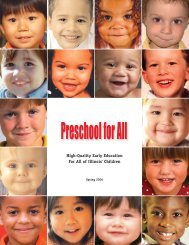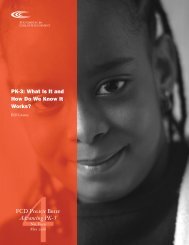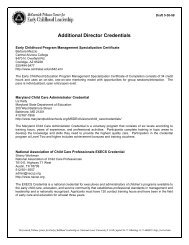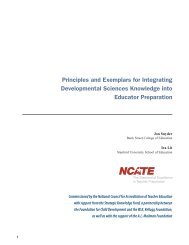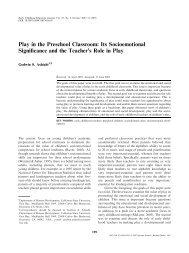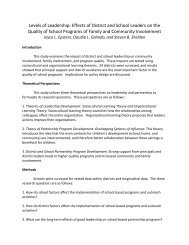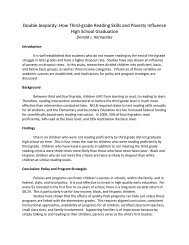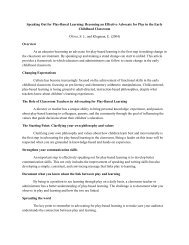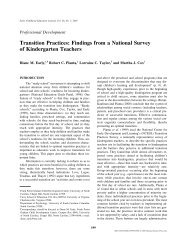Child Outcome Standards in Pre-K Programs - National Institute for ...
Child Outcome Standards in Pre-K Programs - National Institute for ...
Child Outcome Standards in Pre-K Programs - National Institute for ...
You also want an ePaper? Increase the reach of your titles
YUMPU automatically turns print PDFs into web optimized ePapers that Google loves.
<strong>Pre</strong>school Policy Brief March 20046<strong>Standards</strong> should make sense to teachers and helpthem with their day-to-day work.S<strong>in</strong>ce the goal is to affect what children learn, standardsonly work if the skills and concepts children are expectedto master are the same skills and concepts they are taught<strong>in</strong> the classroom and the same skills and concepts that aremeasured by assessments. Teachers must to be able toorient the educational experiences they offer to the skillsand content specified <strong>in</strong> the child outcome standards.For this to happen, the content of the standards mustbe developmentally appropriate, and standards should bespecific enough to allow teachers to know what is expectedof their students.Teachers should be able to align curriculum and classroomassessments with the standards. This alignment is crucial tothe effectiveness of standards. As analysts have observed, 7,19,20standards-based re<strong>for</strong>m can be expected to produce a positiveimpact on student learn<strong>in</strong>g only when an <strong>in</strong>structionalsystem is “...driven by content standards, which aretranslated <strong>in</strong>to assessments, curriculum materials,and professional development, which are all, <strong>in</strong>turn, tightly aligned to the content standards.” 20For preschoolers… As noted earlier, youngchildren learn <strong>in</strong> the context of <strong>in</strong>teractionswith important adults and peers. Theirdevelopment and learn<strong>in</strong>g h<strong>in</strong>ge on their<strong>in</strong>dividual developmental pathways andthe experiences they have <strong>in</strong> their homes,communities, and classrooms. For thisreason, there is great variation <strong>in</strong> howand when different children masterthe same knowledge and skills.Early childhood teachers there<strong>for</strong>e need more flexibilitythan K-12 teachers <strong>in</strong> how they implement child outcomestandards, and this flexibility must be built <strong>in</strong>to the standards.<strong>Pre</strong>school child outcome standards must be usedwith reflection, not followed bl<strong>in</strong>dly. 21<strong>Standards</strong> documents should emphasize that teachersshould accommodate children’s learn<strong>in</strong>g strengths, needs,and <strong>in</strong>terests wherever they are on the developmentalcont<strong>in</strong>uum, rather than try<strong>in</strong>g to speed up or slow downtheir learn<strong>in</strong>g. A standards document can make this po<strong>in</strong>t,<strong>for</strong> example, by provid<strong>in</strong>g several levels of per<strong>for</strong>mance <strong>for</strong>a particular standard.Moreover, preschool standards should accommodate notonly specific concepts and skills, but also the foundationalskills (such as listen<strong>in</strong>g or pay<strong>in</strong>g attention) that developas children move throughearly childhood.7




